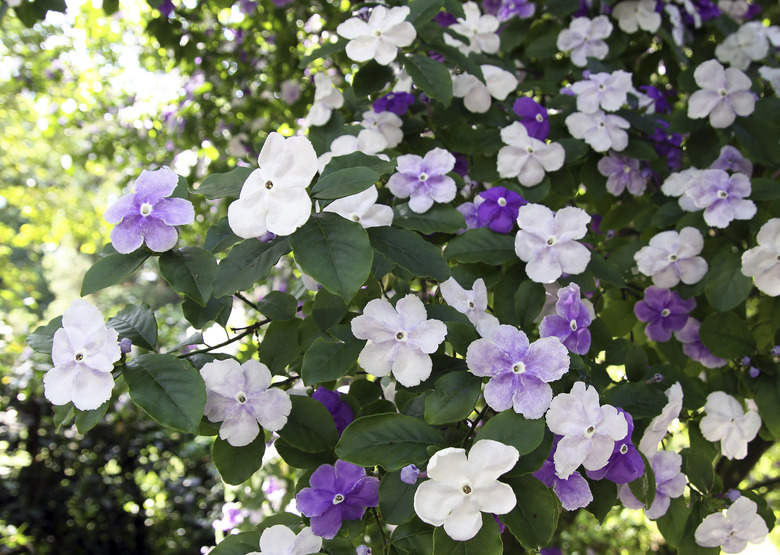How To Grow A Yesterday, Today And Tomorrow Plant
The Yesterday, Today and Tomorrow shrub (Brunfelsia spp.) is named for fragrant, five-petal blooms that fade as they age, usually from purple to lavender to white. According to "The New Sunset Western Garden Book," purple stands for yesterday, lavender for today and white for tomorrow. Generally suited to U.S. Department of Agriculture plant hardiness zones 9 to 12, depending on species, the flowering shrub is often grown as a houseplant elsewhere. Keep in mind that brunfelsia is highly toxic, with yellow or orange berries which could be fatally attractive to children or pets.
Brunfelsia's Portrait
The almost ever-blooming magnificent or royal purple brunfelsia (Brunfelsia pauciflora "Macrantha" or "Royal Purple," USDA zones 10 through 12) probably is the shortest type, at 3 to 4 feet, but produces the largest flowers — up to 4 inches in diameter. The summer-blooming Lady of the Night (Brunfelsia americana, USDA zones 10 through 12), on the other hand, can reach 15 feet with 2-inch flowers that age from white to cream to yellow. Brazil raintree (Brunfelsia pauciflora "Eximia," USDA zones 10 through 12), considered the most popular purple variety, grows to about 8 feet with 2-inch flowers during spring and summer. The most hardy Yesterday, Today and Tomorrow (Brunfelsia australis or latifolia, USDA zones 9 through 12), sometimes also called Kiss Me Quick, may attain 12 feet with 1-inch winter or spring flowers.
Brunfelsia's Plot
The purple, lavender and white brunfelsias prefer a location in rich and slightly acidic soil – preferably with a pH between 5.5 and 6.2 – where they receive sunlight in the morning and shade during the afternoon. The white, cream, and yellow types generally like the same type of soil with sun for at least five hours per day, up to all day. The ground for purple types should be kept lightly moist at all times, from the surface down, while soil for white varieties can be allowed to dry out a few inches beneath the surface before you water them again. The shrubs should be spaced at least 3 to 5 feet away from buildings or other plants. Mulch them heavily with compost or pine needles to preserve their moisture and help protect them during the coldest months. Only semi-evergreen, brunfelsias sometimes drop their leathery leaves during winter.
Brunfelsias's Plant Food
Feed your in-ground brunfelsia once every three months from early spring through fall with an organic granular fertilizer — such as 6-4-4 — formulated for acid-loving plants. Measure out 1/2 cup of the fertilizer for every 2 feet of the shrub's height and work fertilizer into the soil around the plant. For the best bloom from Brunfelsia pauciflora "Macrantha," often grown as a porch plant in frost-free climates, drench its soil with a double dose of a high-nitrogen organic fertilizer such as fish emulsion once in December and again in January, recommends author Pat Welsh in "Southern California Organic Gardening." For a 5-1-1 emulsion, that would be 2 tablespoons of the concentrate per gallon of water for outdoor container plants and about 6 tablespoons per gallon for 2-foot shrubs planted in the ground.
Brunfelsia's Pot
Brunfelsia seldom grows taller than 3 feet when kept in a pot. To raise it as a houseplant, keep it slightly root bound in an acidic potting soil, such as the African violet type. If possible, water your brunfelsia with rainwater rather than hard tap water to keep soil acidic. Place the plant on a windowsill where it receives full or partial sun and temperatures above 50 degrees Fahrenheit, and feed it every two weeks from spring through fall with 1/2 teaspoon of a 15-15-15 plant food per gallon of water. Under those circumstances, some brunfelsias – such as Brunfelsia pauciflora "Macrantha" – can be ever bloomers. Others will flower off and on intermittently throughout the year.
References
- University of Florida IFAS Extension: Brunfelsia grandiflora Yesterday-Today-and-Tomorrow1
- Floridata: Brunfelsia pauciflora
- Flowering Shrubs and Small Trees for the South; Marie Harrison
- Tropical Shrubs; Horace F. Clay
- Gulf Coast Gardening; Randy Lemmon By Randy Lemmon
- San Marcos Growers: Brunfelsia pauciflora 'Macrantha' – Royal Purple Brunfelsia
- Logee's Plants for Home and Garden: Cultural Information—Brunfelsia
- Pat Welsh's Southern California Organic Gardening (3rd Edition): Month by Month; Pat Welsh
